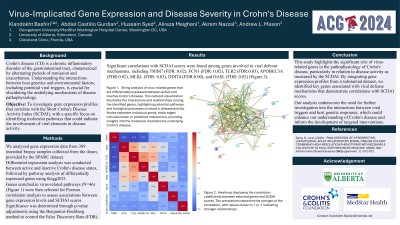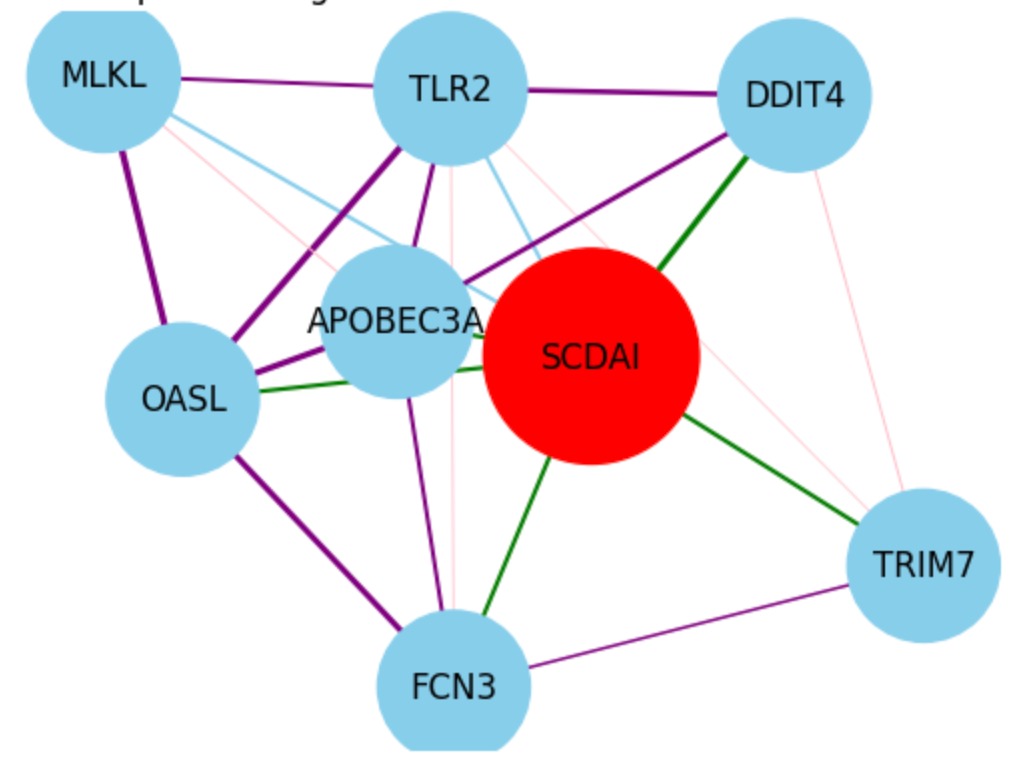Tuesday Poster Session
Category: IBD
P4391 - Pathogenic Crossroads: Viral Defense Genes as Modulators of Crohn's Disease Activity
Tuesday, October 29, 2024
10:30 AM - 4:00 PM ET
Location: Exhibit Hall E


Kiandokht Bashiri, MD, MSc
Georgetown University/MedStar Washington Hospital Center
Washington, DC
Presenting Author(s)
Award: Presidential Poster Award
Kiandokht Bashiri, MD, MSc1, Abdiel Castillo Gurdian, BS2, Hussain Syed, MSc2, Alireza Meighani, MD3, Akram Ahmad, MD4, Andrew L Mason, MD2
1Georgetown University/MedStar Washington Hospital Center, Washington, DC; 2University of Alberta, Edmonton, AB, Canada; 3MedStar Health, Washington Hospital Center, Washington, DC; 4Cleveland Clinic Florida, Weston, FL
Introduction: Crohn's disease (CD) is a chronic inflammatory disorder of the gastrointestinal tract, characterized by alternating periods of remission and exacerbation. Understanding the interactions between host genetics and environmental factors, including potential viral triggers, is crucial for elucidating the underlying mechanisms of disease pathophysiology.
Objective: This study aimed to investigate gene expression profiles that correlate with the Crohn's Disease Activity Index (SCDAI), with a specific focus on identifying molecular pathways that could indicate the involvement of viral elements in disease activity.
Methods: We analyzed gene expression data from 389 intestinal biopsy samples collected from the ileum, provided by the SPARC dataset. Differential expression analysis was conducted between active and inactive disease states, followed by pathway analysis of differentially expressed genes using Reactome. Genes enriched in virus-related pathways were then selected for Pearson correlation analysis to assess associations between gene expression levels and SCDAI scores. Significance was determined through p-value adjustments using the Benjamini-Hochberg method to control the False Discovery Rate (FDR)
Results: Significant correlations with SCDAI scores were found among genes involved in viral defense mechanisms, including TRIM7 (r: 0.157, FDR: 0.0215), FCN3 (r: 0.156, FDR: 0.0215), TLR2 (r: 0.139, FDR: 0.0394), APOBEC3A (r: 0.156, FDR: 0.0215), MLKL (r: 0.142, FDR: 0.0393), DDIT4 (r: 0.215, FDR: 0.000891), and OASL (r: 0.154, FDR: 0.0215). These genes participate in critical antiviral response pathways, suggesting that viral elements may significantly influence the exacerbation and modulation of inflammatory processes in Crohn's disease.
Discussion: Our findings underscore a significant link between viral defense mechanisms and the activity of Crohn's disease, highlighting the potential for viral infections to impact disease progression. This study contributes to a deeper understanding of Crohn's disease pathophysiology and emphasizes the importance of considering viral elements as a contributing factor in its dynamics.

Disclosures:
Kiandokht Bashiri, MD, MSc1, Abdiel Castillo Gurdian, BS2, Hussain Syed, MSc2, Alireza Meighani, MD3, Akram Ahmad, MD4, Andrew L Mason, MD2. P4391 - Pathogenic Crossroads: Viral Defense Genes as Modulators of Crohn's Disease Activity, ACG 2024 Annual Scientific Meeting Abstracts. Philadelphia, PA: American College of Gastroenterology.
Kiandokht Bashiri, MD, MSc1, Abdiel Castillo Gurdian, BS2, Hussain Syed, MSc2, Alireza Meighani, MD3, Akram Ahmad, MD4, Andrew L Mason, MD2
1Georgetown University/MedStar Washington Hospital Center, Washington, DC; 2University of Alberta, Edmonton, AB, Canada; 3MedStar Health, Washington Hospital Center, Washington, DC; 4Cleveland Clinic Florida, Weston, FL
Introduction: Crohn's disease (CD) is a chronic inflammatory disorder of the gastrointestinal tract, characterized by alternating periods of remission and exacerbation. Understanding the interactions between host genetics and environmental factors, including potential viral triggers, is crucial for elucidating the underlying mechanisms of disease pathophysiology.
Objective: This study aimed to investigate gene expression profiles that correlate with the Crohn's Disease Activity Index (SCDAI), with a specific focus on identifying molecular pathways that could indicate the involvement of viral elements in disease activity.
Methods: We analyzed gene expression data from 389 intestinal biopsy samples collected from the ileum, provided by the SPARC dataset. Differential expression analysis was conducted between active and inactive disease states, followed by pathway analysis of differentially expressed genes using Reactome. Genes enriched in virus-related pathways were then selected for Pearson correlation analysis to assess associations between gene expression levels and SCDAI scores. Significance was determined through p-value adjustments using the Benjamini-Hochberg method to control the False Discovery Rate (FDR)
Results: Significant correlations with SCDAI scores were found among genes involved in viral defense mechanisms, including TRIM7 (r: 0.157, FDR: 0.0215), FCN3 (r: 0.156, FDR: 0.0215), TLR2 (r: 0.139, FDR: 0.0394), APOBEC3A (r: 0.156, FDR: 0.0215), MLKL (r: 0.142, FDR: 0.0393), DDIT4 (r: 0.215, FDR: 0.000891), and OASL (r: 0.154, FDR: 0.0215). These genes participate in critical antiviral response pathways, suggesting that viral elements may significantly influence the exacerbation and modulation of inflammatory processes in Crohn's disease.
Discussion: Our findings underscore a significant link between viral defense mechanisms and the activity of Crohn's disease, highlighting the potential for viral infections to impact disease progression. This study contributes to a deeper understanding of Crohn's disease pathophysiology and emphasizes the importance of considering viral elements as a contributing factor in its dynamics.

Figure: Network Graph Showing Selected Gene Correlations with SCDAI and Each Other
Disclosures:
Kiandokht Bashiri indicated no relevant financial relationships.
Abdiel Castillo Gurdian indicated no relevant financial relationships.
Hussain Syed indicated no relevant financial relationships.
Alireza Meighani indicated no relevant financial relationships.
Akram Ahmad indicated no relevant financial relationships.
Andrew L Mason indicated no relevant financial relationships.
Kiandokht Bashiri, MD, MSc1, Abdiel Castillo Gurdian, BS2, Hussain Syed, MSc2, Alireza Meighani, MD3, Akram Ahmad, MD4, Andrew L Mason, MD2. P4391 - Pathogenic Crossroads: Viral Defense Genes as Modulators of Crohn's Disease Activity, ACG 2024 Annual Scientific Meeting Abstracts. Philadelphia, PA: American College of Gastroenterology.

